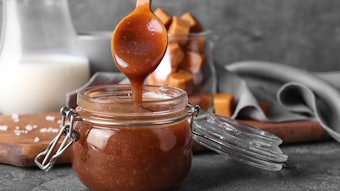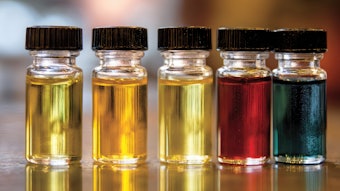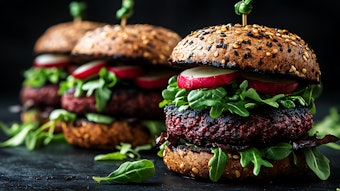
It has been a while since I have had the chance to write a column for you all and I’m hoping that this one makes up for the lag in time. This grouping comes to you from the Master Class session presented at Flavorcon 2024. That means that this may have wider perspectives/viewpoints than normal. And I find that a wonderful thing!
gamma-valerolactone, natural
Source: Vigon
FEMA# 3103, CAS# 108-29-2
Naturally occurring: Barley, beef, beer, bread dough, gruyere, Parmesan & Swiss cheeses, chicken, cocoa, coffee, date, hazelnut, flax, hemp, honey, mango, butter, yogurt, mushroom, olive, peach, peanut, plum, pork, rooibos tea, soybean, strawberry, tea, tomato, vanilla, wild rice, wine, yeast extract.
Odor 1%: Slightly sweet, coumarin, coconut, hay-like, doughy, creamy, brown, powdery, dry and woody on the dry out.
Taste @ 4 ppm: Woody, dry, hay-like, nutty, white bread,
Possible applications: I’ve always been fond of lactones and, in particular, the short chain ones. gamma-valerolactone is a favorite to use for seedy and woody notes. I think of stone fruits, raspberries and all the other berries, cherry and apricot. I also think of nuts like pistachio, almond, walnut and hazelnut. It’s not difficult to imagine the woody aspect figuring into a sake, sherry, wine, beer or whiskey profile. And I think it works well in cocoa, chocolate and coffee profiles. Others felt that this would perform well in cookie dough, brownie batter, and other bakery profiles. Other concepts are rice, white bread and popcorn as well as macadamia and Brazil nut profiles. Butter and cheese also come to mind as well.
Rosehip Extract
Source: Mane (Kancor)
FEMA# 2990, CAS# 8007-01-0
Odor @ 1%: Delicate, floral profile which builds to rose over time. Seedy, berry and red fruit notes.
Taste @ 3 ppm: Floral
Possible applications: A rosehip is the small berry-like structure left on the plant after the petals fall off the flower. The botanical species is Rosa canina. (For this session, I put the rosehip extract in ethanol and overnight the solution dumped some solids on the bottom of the bottle. Simple filtration took care of that. The filtered ethanolic extract is what we tasted.) Floral profiles can be quite difficult to deal with in flavors. However, this one is quite versatile and lends itself to stone fruits such as plum, apricot, peach, and although not considered stone fruits, lychee and rambutan. I would use this in a fresh fig profile, all berries, watermelon, papaya guava, grape, pomegranate and finally red apple. Additional fruity profiles include cranberry, red currant, black cherry and of course cherry blossom. This would fit nicely into amaretto and red wine and even dark chocolate. Others found this to be useful for mango, dried fruit, honey, and for woody and tobacco notes.
Lastly, I will mention that this would add a note of interest to orange/mandarin/clementine profiles differentiating it from the pack!
 The 2024 Master Class took 35 attendees on a guided tour through a lineup of organoleptic materials.Peter Wynn Thompson
The 2024 Master Class took 35 attendees on a guided tour through a lineup of organoleptic materials.Peter Wynn Thompson
1,1-Diethoxy-3-methylbutane
Source: Millipore Sigma
FEMA# 4371, CAS# 3842-03-3
Naturally occurring: Anise, apple, celery, grape, pear, plum brandy, capers, cocoa, port wine, potato, blackberry, rum, sherry, wheat bread, whiskey, wine.
Odor @ 1%: Chocolate/cocoa, nutty, musty, earthy, malt, rum woody, coffee, slightly choking and reminiscent of coffee breath.
Taste @ 10 ppm: Chocolate, nutty, musty, malt, bread crust, caramel.
Possible uses: Even though this material sounds like poison, this is actually isovaleraldehyde diethyl acetal. It becomes so much friendlier when examined under that light, doesn’t it? Anyway, this reaction product would work very well in chocolate or cocoa, nutty profiles such as almond or praline, and malt. This would work well in oak aged profiles such as whiskey, port, red wine, and oak aged vinegar. We thought it would be interesting to add to an ube flavor and one audience member volunteered pisco as a flavor profile to try.
Kabosu oil
Source: Berje’
FEMA# 4864, CAS# 2182693-25-8
Odor @ 1%: Citrus, lime, grapefruit, lemon, fresh, pith, orange, bright, green lifting, blueberry, tangerine, calamansi, tropical, floral and powdery on the dry out.
Taste @ 2 ppm: Sweet citrus, orange, grapefruit, pomelo, more aldehydic than odor.
Possible applications: The botanical species is Citrus sphaerocarpa, and it is a beautiful, round green fruit that has many seeds. Grown in Japan, this little beauty is a chameleon for citrus. This can be added to any citrus profiles, but I feel it would be especially helpful in red grapefruit and pomelo to pronounce and differentiate from standard profiles. Others felt that this would have a welcome home in naval orange, clementine, kumquat, tangerine and yuzu. Expanding on that a bit this could be beautiful in a negroni or old-fashioned cocktail profile. I also think this would work for apple skin notes and in fresh carrot.
 Hands-on learning and networking started early at Flavorcon 2024 with the help of the interactive Master Class. Seasoned and green flavorists alike shared their thoughts on materials.Peter Wynn Thompson
Hands-on learning and networking started early at Flavorcon 2024 with the help of the interactive Master Class. Seasoned and green flavorists alike shared their thoughts on materials.Peter Wynn Thompson
Cinnamyl isovalerate, natural
Source: Avant Organics
FEMA# 2302, CAS# 140-27-2
Naturally occurring: Chestnut.
Odor @ 1%: Slightly heavy and cinnamic, powdery, woody, oak barrel and leathery, waxy, smoky, slightly overripe.
Taste @ 2 ppm: Fatty, mouthcoating, cinnamic, waxy, heavy, woody.
Possible applications: Cinnamyl isovalerate would work in an array of flavors including cinnamon (baking type), asparagus, potato, artichoke, yeast, and savory sauces. It has a slightly fermented, raw dough and yeasty impact that would perform well in beer, balsamic vinegar and aged wine. The heavy mouthfeel would add to waxy profile and perhaps smoke, cheese and tobacco flavors as well. Closely monitor use levels, as there can be putrid note detectible.
Magnolia flower oil, P&N
Source: Excellentia
FEMA# 3950, CAS# 92457-18-6
Odor @ 1%: Sweet, floral, tart, ‘orange color’, bright, green, melon.
Taste @ 1 ppm: Bright, floral, jammy, herbal, thyme, oregano, slightly metallic.
Possible applications: For me, I have a few special raw materials which make my eyeballs roll back into my head. This is one of them. I can see this in a white peach, apricot, orange marmalade, rhubarb, plum, date, fig and tomato. Other profiles suggested are melons, cucumber, hops/IPA, rhubarb and marigold, dried fruity, tobacco, tea and clary sage.










